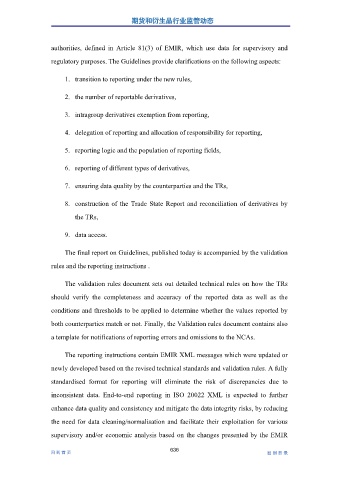Page 734 - 《期货和衍生品行业监管动态》(2022年合集)
P. 734
期货和衍生品行业监管动态
authorities, defined in Article 81(3) of EMIR, which use data for supervisory and
regulatory purposes. The Guidelines provide clarifications on the following aspects:
1. transition to reporting under the new rules,
2. the number of reportable derivatives,
3. intragroup derivatives exemption from reporting,
4. delegation of reporting and allocation of responsibility for reporting,
5. reporting logic and the population of reporting fields,
6. reporting of different types of derivatives,
7. ensuring data quality by the counterparties and the TRs,
8. construction of the Trade State Report and reconciliation of derivatives by
the TRs,
9. data access.
The final report on Guidelines, published today is accompanied by the validation
rules and the reporting instructions .
The validation rules document sets out detailed technical rules on how the TRs
should verify the completeness and accuracy of the reported data as well as the
conditions and thresholds to be applied to determine whether the values reported by
both counterparties match or not. Finally, the Validation rules document contains also
a template for notifications of reporting errors and omissions to the NCAs.
The reporting instructions contain EMIR XML messages which were updated or
newly developed based on the revised technical standards and validation rules. A fully
standardised format for reporting will eliminate the risk of discrepancies due to
inconsistent data. End-to-end reporting in ISO 20022 XML is expected to further
enhance data quality and consistency and mitigate the data integrity risks, by reducing
the need for data cleaning/normalisation and facilitate their exploitation for various
supervisory and/or economic analysis based on the changes presented by the EMIR
636
回 到 首 页 回 到 目 录

